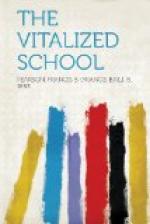=The child as a whole.=—Here is the crux of the entire matter, here the big problem for the vitalized school. We have been taking his pulse, testing his eyes, taking his temperature, and making examinations for defects—and these things are excellent. But all these things combined do not reveal the child to us. We need to go beyond all these in order to find him. We must know what he thinks, how he feels as to people and things, what his aspirations are, what motives impel him to action, what are his intuitions, what things he does involuntarily and what through volition or compulsion. With such data clearly before us we can proceed to attach school work to his native interests. We have been striving to bend him to our preconceived notion instead of finding out who and what he is as a condition precedent to intelligent teaching.
=Three types of teachers.=—The three types of teachers that have been much exploited in the books are the teacher who conceives it to be her work to teach the book, the one who teaches the subject, and the one who teaches the child. The number of the first type is still very large in spite of all the books that inveigh against this conception. It were easy to find a teacher whose practice indicates that she thinks that all the arithmetic there is or ought to be is to be found in the book that lies on her desk. It seems not to occur to her that a score of books might be written that would be equal in merit to the one she is using, some of which might be far better adapted to the children in her particular school. If she were asked to teach arithmetic without the aid of a book, she would shed copious tears, if, indeed, she did not resign.
=The first type.=—To such a teacher the book is the Ultima Thule of all her endeavors, and when the pupils can pass the examination she feels that her work is a success. If the problem in the book does not fit the child, so much the worse for the child, and she proceeds to try to make him fit the problem. It does not occur to her to construct problems that will fit the child. When she comes to the solution of the right triangle, the baseball diamond does not come to her mind. She has the boy learn a rule and try to apply it instead of having him find the distance from first base to third in a direct line. In her thinking such a proceeding would be banal because it would violate the sanctity of the book. She must adhere to the book though the heavens fall, and the boy with them.
=The book supreme.=—She seems quite unable to draw upon the farm, the grocery, the store, or the playground for suitable problems. These things seem to be obscured by her supreme devotion to the book. She lacks fertility of resources, nor does she realize this lack, because her eyes are fastened upon the book rather than upon the child. Were she as intent upon the child as she is upon the book, his interests would direct attention to the things toward which his inclinations yearn and toward which his aptitudes lure him. In such a case, her ingenuity and resourcefulness would roam over wide fields in quest of the objects of his native interests and she would return to him laden with material that would fit the needs of the child far better than the material of the book.




